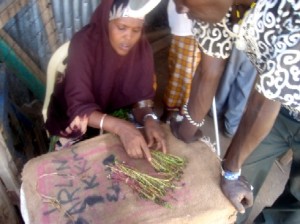
Volume 1, Issue 1 / December 2008
Drug abuse among the youth in Kakuma Refugee Camp is a serious and persistent problem. It has caused many youth to lose their hopes, great expectations, and also their dignity. Youth as young as ten years of age are using drugs, while cases of bhang smoking are reported among children as young as seven years of age.
The most common substances abused by youth in the camp are miraa, bhang, and alcohol. Miraa, also known as khat or ganja, is a mild stimulant herb. The leaves and stalk are peeled and chewed from cuttings of the plant, and are often taken together with chewing gum, peanuts, cardamom spices, soda, coffee, or water. Crops are grown primarily among miraa-farming communities in Somalia, Ethiopia, and eastern Kenya. Miraa is often used in social gatherings among Somali camp communities. People who chew the drug describe it as creating a strong buzz similar to that produced by drinking coffee, while others describe it as causing a “brain imbalance.” A half-kilo bundle of miraa costs 400 Kenya shillings.
Bhang, also known as strong tobacco and Fege, is a hallucinatory drug. Although many youth are reported to use bhang, its source remains unknown and only users know where to buy the drug. It is smoked by rolling bits of substance into an ordinary piece of paper, twisting, and lighting one end.
Alcohol is available in the camp in the form of beer, liquor, and chang’aa, an illicit local brew made of fermented substances.
Motivations for Drug Use
Major factors leading youth to indulge in miraa, bhang, and other strong spirits are harsh life conditions, stress, idleness, and lack of community moral support. Youth report that using these drugs allows them to forget their problems for a while. This is unfortunate, because drug use often leads to more serious life risks.
Drug use is commonly brought about due to peer pressure from other groups. Many youth mimic this behavior when it is exhibited by older friends, while others engage in drugs because of curiosity—just to find out how it feels. Shockingly, many youth indulge in drugs such as alcohol in the presence of their parents who also take it.
I sat down to discuss drug use with several young men and women in the Kakuma community. During our conversation, they admitted that they have no fears when under the influence of drugs. Reports one 19-year old boy: “When I chew miraa for some hours, I see that any human being is too small. Even big old women tell me thank you after having sex with them.”
Some of the youth drug users in Kakuma consider these drugs as a solution to their problems. However, they still accept that many of their peers have lost their lives to such abuses.
Consequences of Drug Use
The consequences of drug use among youth are visible in the communities. Many youth have dropped out of school due to their substance abuse, thereby freeing them to engage in petty business and earn money to purchase drugs. There are frequently fights between youth and adults when they differ on some issue after drinking alcohol. Rape cases are often reported to involve perpetrators under the influence of drugs. Unwanted pregnancies have forced many girls to drop out of school. Prostitution and irresponsible sexual behaviors have also cropped up among youth as a result of drug use.
“I remember one night I went to a disco at Bull’s Eye Resort,” one 21-year old girl told me. “My boyfriend was offering me fegi and beers up to the brim. Just to discover in the following morning that I was sleeping in a one-room lodge in Kakuma town. Three months later, I tested HIV positive. Now I live with it and life is better.”
What is being done about it?
Camp leaders and implementing agencies have initiated some programs meant to curb drug use among youth. The IRC substance Abuse Program, NCCK, and LWF Youth and Culture all sponsor programs and activities to bring youth together to talk about their problems and discuss alternative solutions.
These problems can be solved. LWF Youth and Culture, for example, encourages peer counseling through youth clubs. Club members mobilize their peers, both drug users and non-drug users, to participate in sports, poetry, or music activities. In the process, some youth begin to feel accepted and cared for, and behavioral changes take place. Due to some persistent social or financial problems, other youth do not completely change their behaviors. In another approach, the IRC Substance and Abuse Unit conducts community workshops and youth meetings to create awareness of the consequences of drug use.
The police are also involved in curbing illegal drug use. So far, they have not been able to contain drug abuse, nor have they been successful in halting the brewing of illicit alcohol (chang’aa) in the camp.
Clearly, intense ongoing efforts are needed to eradicate this social problem. However, some programs such as IRC Substance and Abuse will be closed in 2009 due to budget cuts. It remains uncertain whether other agencies will continue to fight against drug abuse in the coming years.
At this point, the situation of drug use among youth is dire, but prevention campaigns appear to be losing momentum among aid agencies and the community. Good measures should be taken in order to offer realistic and positive alternatives to drug use for youth struggling with harsh life conditions. Such actions will help many youth to achieve their future goals and will create a more positive and creative youth culture in Kakuma.
